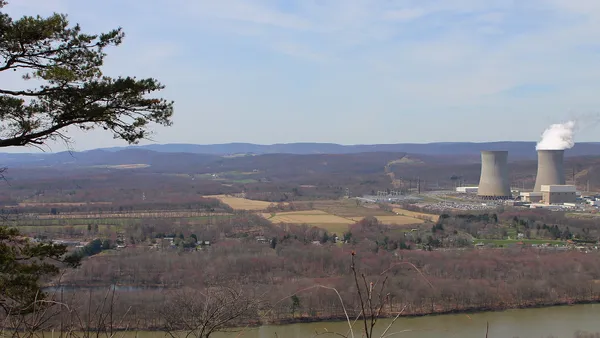Dive Brief:
- Dominion Energy filed its 15-year, long-term integrated resource plan (IRP) for Virginia on Friday, with three separate models to increase solar, wind and energy storage capacity, including mandates from recent clean energy state legislation.
- The utility has 396 MW of solar, 1.8 GW of energy storage and 12 MW of offshore wind under construction or in operation. Under its latest IRP, the utility would add between 6.7 GW and 18.8 GW of solar, up to 2.7 GW of storage and up to 5.1 GW of offshore wind in the next 15 years. It would also add natural gas resources and potentially keep more gas-fired generation on the system to address system reliability.
- Dominion issued a request for proposals on Friday for up to 1 GW of solar and onshore wind and up to 250 MW of energy storage in Virginia. Power purchase proposals are due on March 1 and must be new resources, operational by the end of 2023.
Dive Insight:
The utility "has already begun to transition its generation fleet," having retired more than 2.2 GW of coal, oil and gas-fired generation over the past decade, according to its IRP. According to the Virginia Clean Economy Act (VCEA), the state must have 100% clean energy resources by 2045 and stipulates the addition of up to 5.2 GW of offshore wind.
Dominion proposed four scenarios, including a least-cost "Plan A" that adds over 3.5 GW in the next 25 years, as well as adding nearly 1 GW natural gas capacity in the next 15 years. Plans B, C and D all take into account the VCEA and other legislation passed this spring.
Dominion's four long-term models
Capacity additions for key resources in Virginia, presented in megawatts. Click on the buttons below to see each plan.




Dominion also plans for about 3 GW of fossil fuel retirements under each of the four plans, including the coal-fired Clover Plant Units 1 and 2 by 2025. Under "Plan C" and "Plan D," 9.7 GW of natural gas units would also be retired in the next 25-years. The IRP posits that the large amount of natural gas capacity could be replaced with new types of generation including advanced nuclear, or be converted into low-carbon units through carbon capture sequestration or hydrogen refueling.
Clean energy groups applauded Dominion's proposed expansion of solar power, although many will continue pushing the utility to use cleaner resources to address its reliability concerns.
"We think that there could be room for more offshore wind, more onshore wind, and that could negate what [Dominion thinks] is their need for additional fracked gas plants," Dori Jaffe, senior attorney with Sierra Club, told Utility Dive.
Onshore wind is not listed in the IRP snapshot as a major resource for capacity additions, unlike offshore wind and solar, because of its higher price.
"When we look at 2020, and we look at the generation resources that are most viable in Virginia for our customers ... onshore wind is more challenging from a cost perspective," Rayhan Daudani, Dominion spokesperson, told Utility Dive.
Sierra Club also noted that Dominion is not aiming to surpass the suggested amount of offshore wind included in the VCEA.
Dominion will be fully building out its offshore lease area with 2.6 GW of wind, according to Daudani. The utility is currently seeking permitting approval from the U.S. Bureau of Ocean Energy Management, but other offshore wind developments could also serve Dominion's customers, he said.
Clean energy advocates are also expected to focus in their IRP comments on Dominion's status as a member in the PJM Interconnection. Given the minimum offer price rule policy that PJM is working to implement, renewable energy resources being incentivized in the state would have a more difficult time competing, and Jaffe said Sierra Club will be asking Dominion to consider exiting the PJM capacity market in Virginia and only meeting the fixed resource requirement instead.
AEP-subsidiary Appalachian Power has already been using the fixed resource requirement in the state, but while that option is on the table, Dominion has not made any decision between that alternative and the MOPR.
"Once we have a better sense of where [the Federal Energy Regulatory Commission] and PJM end up, then we can really form a path forward, but for the time being we don't have any further in-depth analyses on the impacts," Daudani said.
Dominion is holding its first quarter analyst call on Tuesday to discuss the utility's near-term future.














